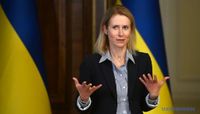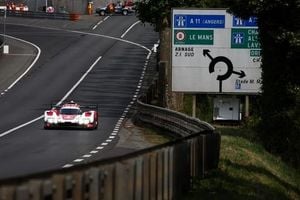On the eve of a pivotal European Council meeting in Brussels, debates over how to support Ukraine in its war against Russia are intensifying across both sides of the Atlantic. At the heart of the discussion: whether the United States will return to a strategy of ramping up sanctions on Moscow, and how the European Union might use frozen Russian assets to finance Ukraine’s defense and reconstruction.
David O'Sullivan, the EU's sanctions envoy, expressed his hopes that the U.S. would soon rejoin the bloc’s efforts to tighten the economic screws on Russia. Speaking to Euronews on October 14, 2025, O'Sullivan acknowledged that U.S. President Donald Trump’s recent approach has favored direct negotiation and engagement with Russian President Vladimir Putin, rather than imposing new sanctions. But, as O'Sullivan pointed out, these diplomatic overtures have yet to yield results.
“It’s clear Putin is not responding,” O’Sullivan told Euronews, referencing several failed attempts to bring Russia’s president to the negotiating table. In August, President Trump launched a major diplomatic initiative in Alaska, hoping to secure a ceasefire and a trilateral meeting with Ukraine. Neither goal materialized, and Trump reportedly left the talks frustrated by what he saw as Putin’s disingenuousness during the process.
“We wait to see exactly how President Trump responds to that, because he has shown irritation, even frustration with President Putin,” O’Sullivan said. Now, the U.S. president is “talking about sending additional military aid to Ukraine,” including long-range missiles—a move prompted by Ukraine’s persistent requests for more advanced weaponry to counter Russian forces. O’Sullivan added, “We hope that Trump will draw from the experience he’s had until now that Putin clearly doesn’t want peace.”
Meanwhile, the EU is close to passing its 19th sanctions package against Russia. This new round of measures is notable for including, for the first time, a future ban on Russian liquified natural gas (LNG). The EU remains one of the world’s largest importers of Russian LNG, and, according to a Greenpeace report, imports actually rose by 11% in 2024 compared to 2023. O’Sullivan admitted to Euronews that the U.S. “have not been enforcing sanctions to the same extent in the first few months of this year because they wanted to put the effort on mediation and on brokering a peace deal,” but he emphasized that “they still have substantial sanctions.”
The EU, he said, will “continue to apply our sanctions in conjunction with the rest of the G-7, and we hope that the US will rejoin us very soon.”
But sanctions are only one piece of the puzzle. Brussels is also weighing a bold proposal from the European Commission: a reparations loan for Ukraine, backed by approximately €140 billion of frozen Russian assets, most of which are held in Euroclear, a Belgian-based securities depository. Under this plan, Ukraine would receive a loan based on the cash balances linked to these immobilized Russian assets. Each EU member state would share the risk of the loan.
The legal structure is complex. According to the European Commission, the assets themselves would not be touched—unless, at some future point, the war ends and Russia is called upon to make reparations and payments for reconstruction. Ukraine would only be obligated to repay the loan if Russia fulfills its responsibility to pay for the massive damage caused by the war. As O’Sullivan explained to Euronews, “It’s not confiscation, because exactly as you say, Russia will get this back if they pay the reparations. It’s their choice. If they choose not to pay the money they owe for the destruction they have caused in Ukraine, then indeed Ukraine has some call on those assets in Europe as compensation.”
He continued, “We’re not saying that we are going to appropriate these assets, what we are saying is we’re holding them until we see how Russia is going to step up for its responsibilities and the undoubted debts that it owes for the reconstruction of Ukraine with the massive destruction, deliberate destruction of civilian infrastructure that we have seen.”
The question of how Ukraine should use any funds from such a reparations loan has also come to the fore. During a joint press conference with Ukrainian President Volodymyr Zelensky, EU official Kaja Kallas asserted that only Ukraine should determine how to spend the money. According to Ukrinform, Kallas stated that Ukraine knew best what military capabilities it needed—whether Patriot air defense systems, Tomahawk missiles, or other types of equipment—and that it was not for others to dictate those choices. “Ukraine should also be the one to decide how to use the funds in case the idea of a ‘reparations loan’ were approved,” she said.
This view is shared by other EU officials. On October 13, 2025, European Commission Vice-President Maroš Šefčovič and Commission President Ursula von der Leyen also addressed the issue of frozen Russian assets for Ukraine, emphasizing that the proposed reparations loan would be guaranteed by these assets and that Ukraine would only have to repay if Russia pays reparations for war damages.
For Ukraine, the stakes are high. President Zelensky has repeatedly argued that Russia fears the transfer of Tomahawk missiles to Ukraine, believing that such a move could help bring about peace. U.S. President Trump has said that Ukraine could receive Tomahawk cruise missiles if Russia refuses to pursue a peaceful settlement. The prospect of more advanced weaponry for Ukraine is seen by Kyiv as both a deterrent and a bargaining chip in ongoing efforts to end the conflict.
The European Council meeting scheduled for October 23 in Brussels is expected to take up these issues in earnest. Further support for Ukraine—especially through the use of frozen Russian assets—will be a major topic of discussion. Zelensky is set to attend the summit, hoping to secure more robust backing from European leaders at a critical juncture in the war.
In the background, the EU’s approach to Russian assets is being watched closely by legal experts and policymakers worldwide. The European Commission has gone to great lengths to stress that its proposal does not amount to confiscation. Instead, the assets are being used as leverage: a way to compel Russia to pay for the destruction wrought in Ukraine, while offering Kyiv immediate financial support for its defense and eventual reconstruction.
As the war grinds on, the transatlantic alliance faces tough choices. Will the U.S. return to a policy of stricter sanctions, or continue to prioritize direct diplomacy with Moscow? Can the EU’s innovative financial maneuvers deliver meaningful support to Ukraine without triggering legal or political backlash? And, perhaps most importantly, will these efforts be enough to shift the balance and bring about a lasting peace?
For now, Ukraine and its allies are keeping their options open, determined to hold Russia accountable and to ensure that the costs of war are not borne by the victims alone.




